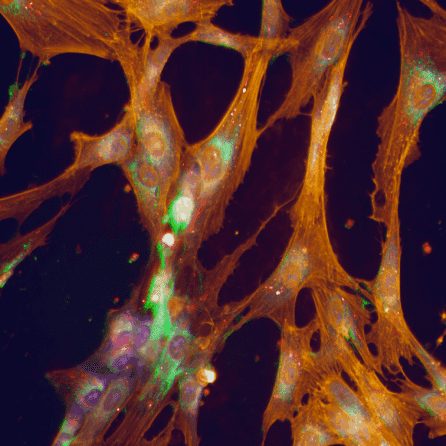Drug Discovery for Parkinson’s
NewsSometimes, personal experience can fuel accelerated research and promise advanced cures. Eight years ago at the age of 49, Jonathan Silverstein received a grim diagnosis: Parkinson’s disease (PD) with a mutation in the GBA gene (PD-GBA). This particularly aggressive form of PD is still poorly understood relative to other forms of the disease, and treatment options remain elusive. Silverstein, a successful health care venture capitalist at OrbiMed, immediately directed his professional expertise, fueled by personal urgency, to accelerating a cure for patients. With his wife Natalie, he established The Silverstein Foundation for Parkinson’s with GBA.

Recognizing the lack of progress in finding a cure for PD using traditional models, Silverstein invested in the potential of induced pluripotent stem cells (iPSCs). In 2022, The Silverstein Foundation approached NYSCF about a partnership centered around our unique technology platform, the NYSCF Global Stem Cell Array® (“the Array”), which combines automation, cell imaging, and machine learning. While iPSCs hold extraordinary promise for the study and treatment of diseases like PD-GBA, a lack of iPSCs with GBA mutations proved an impediment to progress. With support from The Silverstein Foundation, NYSCF set out to address this challenge by using our Array to create a large repository of PD-GBA cells.
Through our Silverstein partnership, NYSCF built the world’s largest collection of iPSCs made from patients with PD-GBA, which is now available to the wider research community. To date, NYSCF’s analysis of these cells has resulted in a massive dataset of PD-GBA cell images – an unprecedented 20 terabytes of information. We have used this extensive dataset to train an algorithm to recognize images of PD-GBA cells. Because the algorithm can distinguish PD-GBA cells from healthy cells by discerning subtle differences in cellular features that are invisible to the human eye, it enables us to identify any compounds that make the PD-GBA cells look “healthy.” Most recently, after testing 989 compounds on our PD-GBA cells, this algorithm identified 14 potential therapeutic solutions. This is a significant step toward identifying drugs that could slow or even stop progression of the disease.
